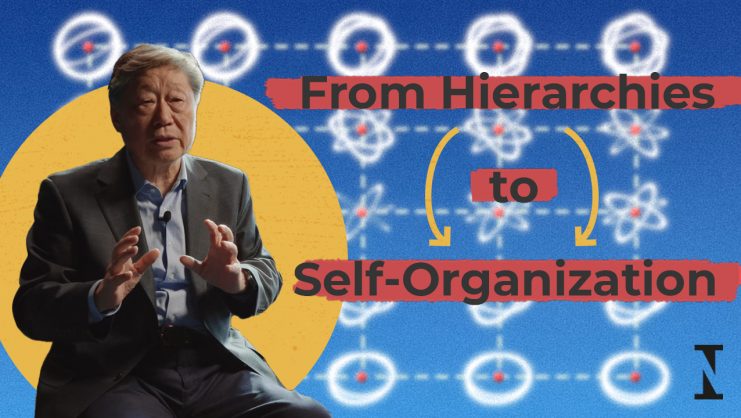In situations of collective stress, such as natural disasters and war, we put our trust in our leaders to bring us back to a state of normality and communal resilience. In fact, leadership, or at least the sense of it, has long been linked with crises because it is in these moments when the leaders who are in charge in that precise moment find themselves leading a collective action.
For example, George W. Bush’s presidency was rather nondescript with 51% of Americans’ approval ratings until the 9/11 attacks transformed opinion and his image. “His job approval rating reached 86% by late September,” according to Pew research. Additional academic research shows that this increase is partly due to the president’s communication style: his speeches in the six months following the crisis became less concrete and tangible, referred more frequently to the country’s collective history and identity, and used moral justification more often than instrumental justification. The crisis also lifted New York Mayor Rudolph Giuliani, who experienced a “myth-making moment” at a time when his reputation was on the line.
Going a bit further back in US history, President Jimmy Carter’s approval rating rose sharply due to his initial handling of the Iranian hostage crisis. That stature in the eyes of voters, however, did not follow Carter into the next presidential election.
It is certainly not a given, though, that a leader’s increased popularity during a crisis will translate into actually solving the problem at hand. For example, Boris Johnson rode the Brexit wave of popularity without providing an actionable plan or clear solutions—and he has since washed ashore. Indeed, more often than not, the expectations placed on leaders (and those they place on themselves) differ greatly from the reality of their decisions.
Heroics tend to push dogmatic leaders into making overly risky decisions.
Putting leaders on a pedestal and revering them as heroes is known as the romance of leadership, a concept in which followers see the charisma of a leader as an innate gift, one with the power to protect them from danger. This romanticism is a double-edged sword. While the magnetism of the charismatic leader instills optimism – within everyone – for the future, heroics tend to push dogmatic leaders into making overly risky decisions. A leader’s charisma can blind their followers, yes, but it can also blind them from reality and lull them into being ill-prepared and without contingency plans.
Of course, crises never cease for leaders, particularly those in the political sphere. So, rather than trying to avoid crises, perhaps it’s better to understand the pressure points of leadership. In their article, “Public Leadership in Times of Crisis: Mission Impossible?” Arjen Boin and Paul ‘t Hart, identify five inconsistencies between popular expectations and political reality:
- Safety. While leaders are expected to prioritize public safety, they tend to settle for less-than-ideal levels of safety after considering its economic and political costs.
- Preparedness. Leaders should be optimistic but they also need to be ready to meet the worst-case scenario. However, leaders generally do not have a crisis prevention mindset until they’ve experienced an emergency firsthand.
- Avoidance. There are usually early-warning signals that a crisis is looming. Yet, the reality is that most leaders ignore the red flags (global warming for example) and wait out the incubation period until the crisis becomes unavoidably apparent.
- Cooperation. Overall, leaders like to think they are in total control of a situation and often use urgency as justification for unilateral use of power. However, complex problems usually require cooperation between multiple stakeholders.
- Trust. The compassion and empathy that leaders show towards others in crisis, particularly the victims of that crisis, can turn out to be simple lip service. When unrealistic promises are made and talk is not followed by action, people lose trust in their leaders.
Today, we find ourselves living through an incredibly disruptive moment in time, with the aftermath of the pandemic and the worldwide healthcare crisis, the war in Ukraine, the growth of populism in the U.S. and Europe, and inflation levels pointing towards an economic recession. It is a climate of distress. In fact, the World Health Organization has found a 25% increase in anxiety and depression due to the pandemic. People feel a lack of energy and mental clarity, an increase in isolation and interpersonal conflicts and thus become less able to cope with everyday challenges. This uncertainty and collective stress increases our general appetite, as a society, for leaders that promise to rescue us from present difficulties and deliver us to a more palatable future.
We know from Albert Bandura’s work on human agency that individuals gain control over their environment in two ways: “self-agency” when they manage their circumstances on their own and “proxy agency” in which control is exerted vicariously by powerful others. In times of crisis, such as war and economic recession, we put our faith in leaders who transform into an antidote to our shared psychological stress.
In his book Leadership in War, Andrew Roberts considers the ways in which some of history’s great leaders dealt with conflict related to war. For example, he explains how Napoleon Bonaparte was a great leader in times of war because of his “meticulous planning, disciple and training, understanding the psychology of the ordinary soldier, inspirational speeches, asking pertinent questions to the right people and a deep learning and appreciation of history.” Here are some recommendations that any leader can make use of in times of crisis:
- Find the middle ground between repair and radical change. Crisis situations put pressure on institutions and the status quo, and this can prompt overly dramatic changes. So, leaders should first prioritize those issues that require an immediate fix and postpone structural shifts that, while necessary in the long term, can create additional — and unwanted – uncertainty in the short term.
- Be receptive to constructive criticism and feedback. Our brains become more rigid when confronted with threatening situations and we actually consider fewer alternatives in order to save energy. Research has consistently shown that acute stress is associated with impaired cognitive flexibility. For example, cortisol response to stress decreases the capacity of individuals to switch tasks. Paradoxically, and unfortunately, moments of flux do require the consideration of multiple views, positions, flexibility, and adjustments and leaders must find the right balance between divergent and convergent thinking (reflection vs action.)
- Retain a long-term approach. Crises demand quick solutions and this urgency triggers unilateral and authoritarian decision-making. However, change does not happen in a silo, even if the decision was made in one, and the effects ripple through the organization and society at large. Therefore, centralized decisions should be reduced to a minimum and until there is a moment of stability for collaborative decisions that have long-term implications.
- Generate a climate of trust. The key to success for leaders in times of crisis is not actually charisma but the ability to inspire trust and confidence. For example, the success of Churchill’s leadership came from courage and the moral compass with which he led, the trust he engendered. The key to Eisenhower’s success was modesty, particularly compared to the ego of other leaders of the time.
Crises are not overcome by heroes but by the power of gathering and inspiring the talent and commitment of many people. When the majority of leaders begin to skew towards the charisma style (and remain low on substance), the social and political consequences are a lack of trust in leaders, with the concomitant economic fallout. Today, according to the 2022 Edelman Trust Barometer, trust in political leaders is at an all-time low, with government credibility falling in 17 of the 27 countries surveyed. Only 42% of people trust public leaders.
We expect our leaders, rightly so, to find solutions to issues regarding safety and security and to ensure our collective well-being. The ongoing military, economic, health, and social challenges endow today’s leaders with increasing importance in the minds of ordinary citizens. This is a shared psychological investment and it opens an opportunity for political and business leaders alike to make a genuine impact in the lives of individuals and society at large. The question is: will they use our trust and their power in this way?
© IE Insights.











